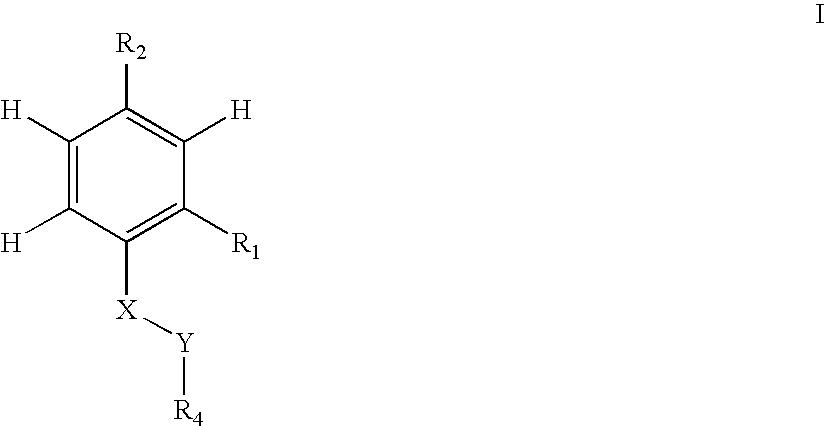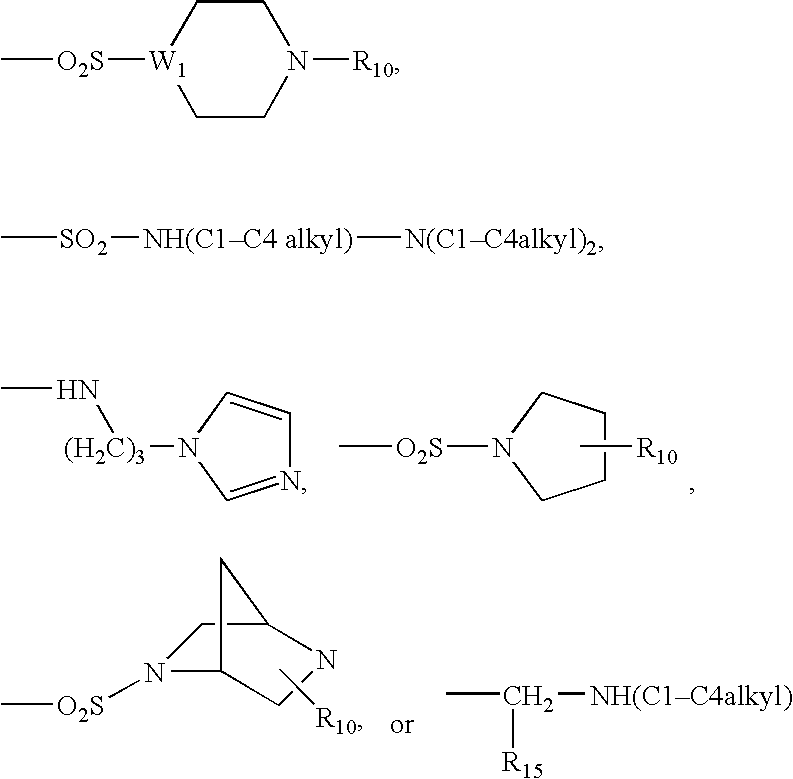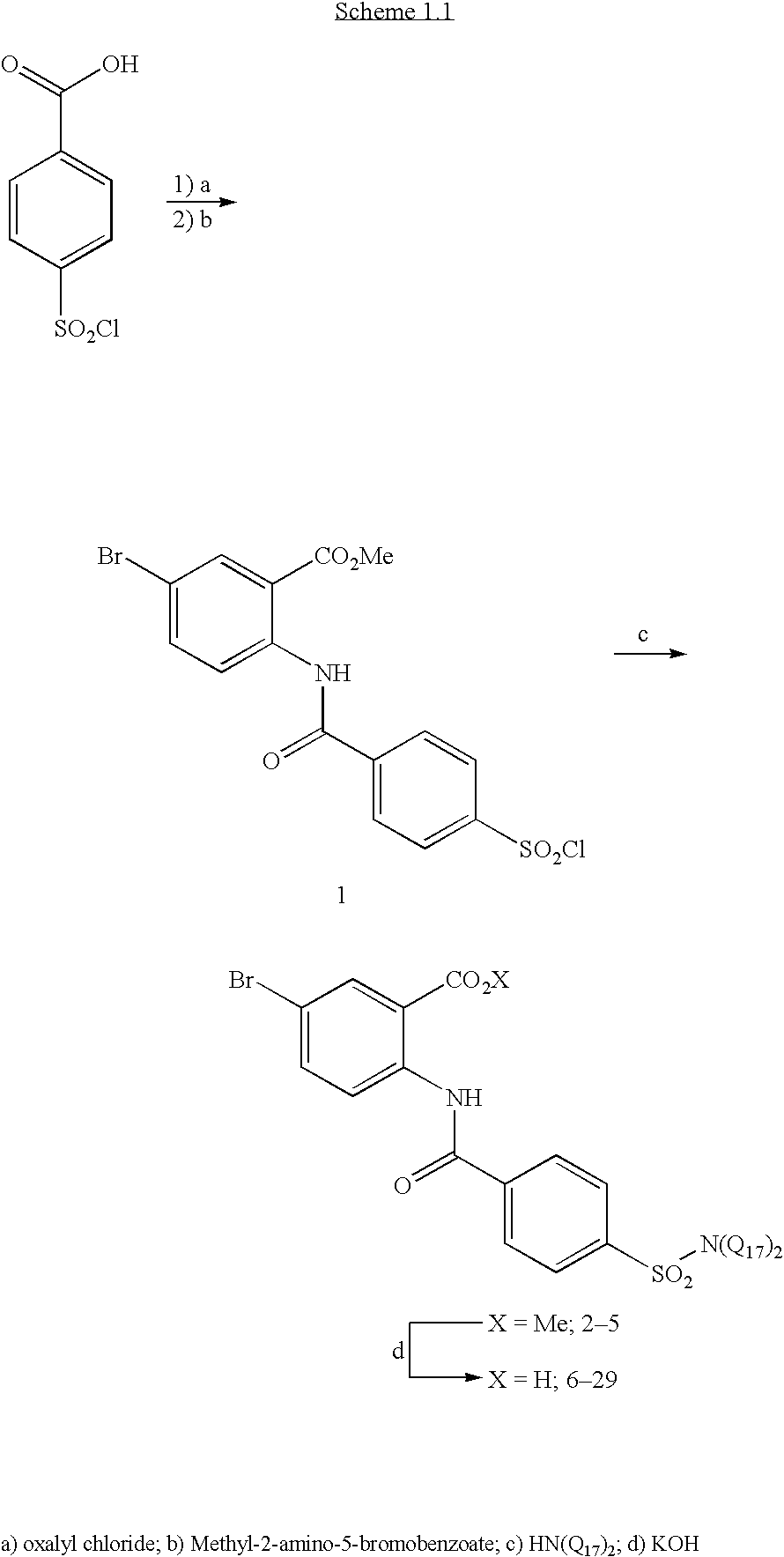Antibacterial agents
a technology of antibacterial agents and antibiotics, applied in the field of antibacterial agents, can solve the problems of inappropriate growth of a variety of bacteria, affecting the survival of bacteria,
- Summary
- Abstract
- Description
- Claims
- Application Information
AI Technical Summary
Benefits of technology
Problems solved by technology
Method used
Image
Examples
example 1
Sulfonyl Derivatives
[0054]
Methyl 5-bromo-2-{[4-(chlorosulfonyl)benzoyl]amino}benzoate
[0055] Methyl 5-bromo-2-{[4-(chlorosulfonyl)benzoyl]amino}benzoate (1) was prepared as a common intermediate for the formation of sulfonamides by the procedure below: 4-(chlorosulfonyl)benzoic acid (18.37 g, 8.33 mmol) was suspended in CH2Cl2 (140 mL) and 4 drops of DMF. The solution was cooled to 0° C. and oxalyl chloride (1.8 mL, 20.6 mmol) was added and stirred for 1 hour, removed from ice bath, and stirred overnight. The clear solution was concentrated in vacuo, redissolved in CH2Cl2, and concentrated in vacuo. The resulting product was dissolved in toluene (140 mL) and refluxed for 30 minutes to remove any HCl gas. After cooling to room temperature, methyl-2-amino-5-bromobenzoate (15.96 g, 69.4 mmol) was added, and the suspension was refluxed overnight. The suspension was cooled to 0° C. and filtered, washing with toluene and quickly with ethyl acetate. The solid was dried in a vacuum oven ov...
example 2
Amine, Ether, and Thioether Derivatives
Preparation of 3-Bromo-4-fluorobenzoic acid
[0263]
[0264] 3-Bromo-4-fluoro-benzaldehyde (10.0 g, 49 mmol) in H2O (150 mL, followed by the addition of KMnO4 (15.5 g, 98 mmol) heated at reflux (foams extensively) for 1 h, then added additional KMnO4 (15.5 g, 98 mmol) and continued heating for another 3 h. The reaction was cooled to rt, then filtered through Celite. The solution was acidified with HCl, and the resulting white precipitate was filtered off, to afford 6.1 g (56%) of a white solid.
Preparation of 3-Anilinobenzoic acid
[0265]
[0266] Methyl 3-bromobenzoate (1000 mg, 4.65 mmol), Pd2(dba)3 (53 mg, 0.058 mmol), Cs2CO3 (2120 mg, 1.4 mmol) and N-[2′-(dicyclohexylphosphino)-1,1′-biphenyl-2-yl]-N,N-dimethylamine (27 mg, 0.07 mmol) were placed in a 100 ml one-necked round bottom flask. The system was evacuated and filled with argon several times. Then aniline (519 mg, 5.58 mmol) was added, followed by the addition of toluene (50 ml). The solutio...
example 3
Ketone Derivatives
2-[(3-Benzoylbenzoyl)amino]-5-bromobenzoic acid
[0300]
[0301] To 3-benzoylbenzoic acid (633 mg, 2.80 mmol, Aldrich) in CH2Cl2 (20 mL) was added DMF (20 μL) and oxalyl chloride (450 μL, 5.16 mmol). The mixture was stirred for 1.7 hours, and the solvent and excess oxalyl chloride were removed by rotary evaporation. The residue was dissolved in CH2Cl2 (20 mL), and methyl 2-amino-5-bromobenzoate (565 mg, 2.46 mmol, Avocado) in pyridine (6 mL) was added. The mixture was stirred overnight and then added to a separatory funnel with 100 mL of CH2Cl2. This solution was washed with 2×100 mL of 1 M aqueous HCl and 100 mL of brine. The CH2Cl2 was evaporated in the presence of silica gel, and the product was purified by chromatography using a Biotage Flash 40 M silica cartridge with a gradient from 75% CH2Cl2 / heptane to 100% CH2Cl2 as eluent. Yield was 825 mg of white solid as the methyl ester. To a mixture of the corresponding methyl ester (645 mg, 1.47 mmol) in dioxane (20 mL...
PUM
| Property | Measurement | Unit |
|---|---|---|
| temperature | aaaaa | aaaaa |
| temperature | aaaaa | aaaaa |
| temperature | aaaaa | aaaaa |
Abstract
Description
Claims
Application Information
 Login to View More
Login to View More - R&D
- Intellectual Property
- Life Sciences
- Materials
- Tech Scout
- Unparalleled Data Quality
- Higher Quality Content
- 60% Fewer Hallucinations
Browse by: Latest US Patents, China's latest patents, Technical Efficacy Thesaurus, Application Domain, Technology Topic, Popular Technical Reports.
© 2025 PatSnap. All rights reserved.Legal|Privacy policy|Modern Slavery Act Transparency Statement|Sitemap|About US| Contact US: help@patsnap.com



